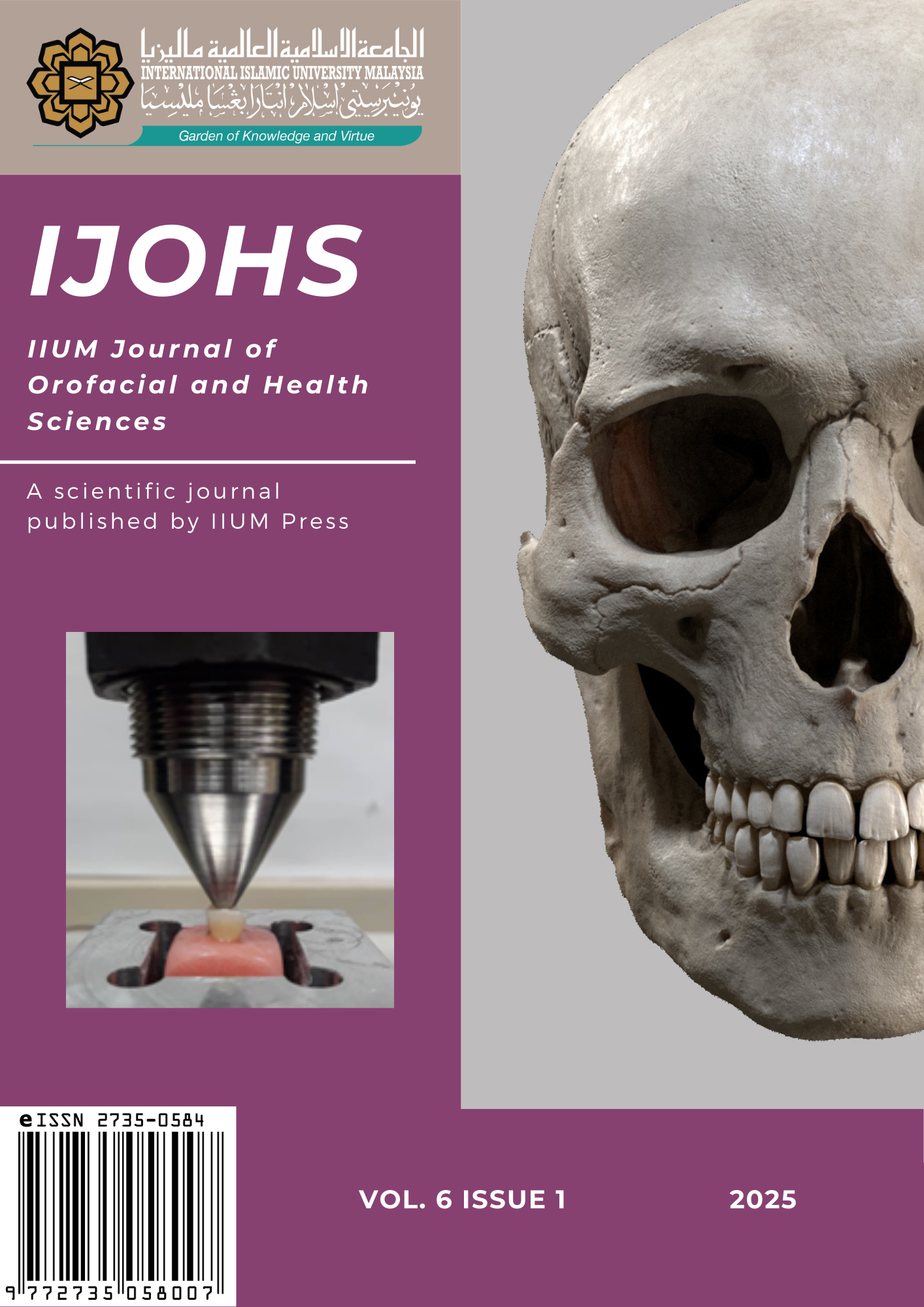The effectiveness of lumbar stabilisation exercises on pain and functional disability among patients with non-specific low back pain: a systematic review
DOI:
https://doi.org/10.31436/ijohs.v6i1.349Keywords:
core stability, exercise training, low back painAbstract
Core stability exercises have emerged as a crucial intervention for managing and preventing back pain, a pervasive condition affecting millions globally. Back pain frequently arises and persists due to deficiencies or imbalances in core muscles. As a result, engaging in targeted core-strengthening exercises is thought to not only reduce pain but also greatly boost functional capabilities and improve overall quality of life. A systematic search of electronic databases (PubMed, ScienceDirect, and PEDro) was conducted to find experimental studies focusing on the impact of core stability exercises on back pain and functional independence in adults with nonspecific back pain. Out of 250 identified studies, 228 titles and abstracts were reviewed, resulting in the exclusion of 122. Among the remaining 106 articles, 93 full texts were retrieved and evaluated for eligibility. Ultimately, 8 studies met the criteria and were included in the review. Out of the eight studies, two reported no improvement in pain reduction compared to control groups. For disability, six studies assessed the outcome, of which three reported no improvement compared to control groups. The remaining studies demonstrated greater effectiveness of core stability exercises in reducing both pain and disability. These findings highlight the importance of incorporating core stability exercises into treatment plans for NSLBP and emphasize the need for tailored exercise programs to optimize outcomes.
References
Aidan, G., Cashina, B., James, H. McAuleya. (2020). Clinimetrics: Physiotherapy Evidence Database (PEDro) Scale. Journal of Physiotherapy.66(59). DOI: https://doi.org/10.1016/j.jphys.2019.08.005
Akodu, A. K., Akindutire, O. M. (2018). The effect of stabilization exercise on pain-related disability, sleep disturbance, and psychological status of patients with non-specific chronic low back pain. Korean Journal of Pain, 31(3), 199–205. https://doi.org/10.3344/kjp.2018.31.3.199 DOI: https://doi.org/10.3344/kjp.2018.31.3.199
Ahmadi, H., Adib, H., Selk-Ghaffari, M., Shafizad, M., Moradi, S., Madani, Z. et al. (2020). Comparison of the effects of the Feldenkrais method versus core stability exercise in the management of chronic low back pain: a randomised control trial. Clinical Rehabilitation, 34(12), 1449–1457. DOI: https://doi.org/10.1177/0269215520947069
Akhtar, M. W., Karimi, H., Gilani, S. A. (2017). Effectiveness of core stabilization exercises and routine exercise therapy in management of pain in chronic nonspecific low back pain: A randomized controlled clinical trial. Pakistan Journal of Medical Sciences, 33(4), 1002–1006. https://doi.org/10.12669/pjms.334.12664 DOI: https://doi.org/10.12669/pjms.334.12664
Balagué, F., Mannion, A. F., Pellisé, F., Cedraschi, C. (2012). Non-specific low back pain. The Lancet, 379(9814), 482-491. https://doi.org/10.1016/s0140-6736(11)60610-7 DOI: https://doi.org/10.1016/S0140-6736(11)60610-7
Bhadauria, E. A., Gurudut, P. (2017). Comparative effectiveness of lumbar stabilization, dynamic strengthening, and Pilates on chronic low back pain: Randomized clinical trial. Journal of Exercise Rehabilitation, 13(4), 477–485. https://doi.org/10.12965/jer.1734972.486 DOI: https://doi.org/10.12965/jer.1734972.486
Frizziero, A., Pellizzon, G., Vittadini, F., Bigliardi, D., & Costantino, C. (2021). Efficacy of Core Stability in Non-Specific Chronic Low Back Pain. Journal of Functional Morphology and Kinesiology, 6, 37. https://doi.org/10.3390/jfmk6020037 DOI: https://doi.org/10.3390/jfmk6020037
GBD. (2021). Low Back Pain Collaborators. Global, regional, and national burden of low back pain, 1990-2020, its attributable risk factors, and projections to 2050: a systematic analysis of the Global Burden of Disease Study 2021. Lancet Rheumatology, 5, e316-29.
Ghorbanpour, A., Azghani M.R., Taghipour, M., Salahzadeh, Z., Ghaderi, F., Oskouei, A.E. (2018). Effects of McGill stabilization exercises and conventional physiotherapy on pain, functional disability and active back range of motion in patients with chronic non-specific low back pain. Journal of Physical Therapy Science, 30(4), 481-485. https://doi.org/10.1589/jpts.30.481 DOI: https://doi.org/10.1589/jpts.30.481
Hoy, D., March, L., Brooks, P., Blyth, F., Woolf, A., Bain, C. et al. (2014). The global burden of low back pain: estimates from the Global Burden of Disease 2010 study. Annals of the Rheumatic Diseases, 73, 968–974. https://doi.org/10.1136/annrheumdis-2013-204428 DOI: https://doi.org/10.1136/annrheumdis-2013-204428
Kim, B., Yim, J. (2020). Core stability and hip exercises improve physical function and activity in patients with non-specific low back pain: A randomized controlled trial. Tohoku Journal of Experimental Medicine, 251(3), 193–206. https://doi.org/10.1620/tjem.251.193 DOI: https://doi.org/10.1620/tjem.251.193
Kumar, S., Sharma, V. P., Negi, M. P. S. (2009). Efficacy of dynamic muscular stabilization techniques (DMST) over conventional techniques in rehabilitation of chronic low back pain. Journal of Strength and Conditioning Research / National Strength & Conditioning Association, 23(9), 2651–2659. https://doi.org/10.1519/JSC.0b013e3181b3dde0 DOI: https://doi.org/10.1519/JSC.0b013e3181b3dde0
Maher, C., Underwood, M., Buchbinder, R. (2017). Non-specific low back pain. Lancet, 389(10070), 736–747. https://doi.org/10.1016/S0140-6736(16)30970-9 DOI: https://doi.org/10.1016/S0140-6736(16)30970-9
Majeed, S., Ts, A., Sugunan, A., Ms, A. (2019). The effectiveness of a simplified core stabilization program (TRICCS - Trivandrum Community-based Core Stabilisation) for community-based intervention in chronic non-specific low back pain. Journal of Orthopaedic Surgery and Research, 14(1), 1–8. https://doi.org/10.1186/s13018-019-1131-z DOI: https://doi.org/10.1186/s13018-019-1131-z
Mohammadi, V., Letafatkar, A., Sadeghi, H., Jafarnezhadgero, A. A., Hilfiker, R. (2017). The effect of motor control training on kinetics variables of patients with non-specific low back pain and movement control impairment: Prospective observational study. Journal of Bodywork and Movement Therapies, 21(4), 1009–1016. https://doi.org/10.1016/j.jbmt.2016.12.009 DOI: https://doi.org/10.1016/j.jbmt.2016.12.009
Paci, M., Bianchini, C., & Baccini, M. (2022). Reliability of the PEDro scale: comparison between trials published in predatory and non-predatory journals. Archives of Physiotherapy, 12(1), 10. https://doi.org/10.1186/s40945-022-00133-6 DOI: https://doi.org/10.1186/s40945-022-00133-6
Page, M. J., McKenzie, J. E., Bossuyt, P. M., Boutron, I., Hoffmann, T. C., Mulrow, C. D. et al. (2021). The PRISMA 2020 statement: an updated guideline for reporting systematic reviews. BMJ, 372, n71. https://doi.org/10.1136/BMJ.N71 DOI: https://doi.org/10.1136/bmj.n71
Shamsi, M. B., Mirzaei, M., Hamedirad, M. (2020). Comparison of muscle activation imbalance following core stability or general exercises in nonspecific low back pain: A quasi-randomized controlled trial. BMC Sports Science, Medicine and Rehabilitation, 12(1), 1–9. DOI: https://doi.org/10.1186/s13102-020-00173-0
Sokunbi, O. G., Muhwhati, L., Robinson, P. (2014). A pilot study on using acupunture and core stability exercises to treat non-specific acute low back paun among industrial workers. South African Journal of Physiotherapy, 70(2), a268. https://doi.org/10.4102/sajp.v70i2.268 DOI: https://doi.org/10.4102/sajp.v70i2.268
Tawfik, G.M., Dila, K.A.S., Mohamed, M.Y.F., Tam, D.N.H., Kien ND, Ahmed, A.M. et al (2019). A step-by-step guide for conducting a systematic review and meta-analysis with simulation data. Tropical Medicine and Health,1(47),46. https://doi.org/10.1186/s41182-019-0165-6 DOI: https://doi.org/10.1186/s41182-019-0165-6
Waseem, M., Karimi, H., Gilani, S. A., Hassan, D. (2019). Treatment of disability associated with chronic non-specific low back pain using core stabilization exercises in Pakistani population. Journal of Back and Musculoskeletal Rehabilitation, 32(1), 149–154. https://doi.org/10.3233/BMR-171114 DOI: https://doi.org/10.3233/BMR-171114
Wu, A., March, L., Zheng, X., Huang, J., Wang, X., Zhao, J. et al. (2020). Global low back pain prevalence and years lived with disability from 1990 to 2017: estimates from the Global Burden of Disease Study 2017. Annals of Translational Medicine, 8(6), 299–299. https://doi.org/10.21037/atm.2020.02.175 DOI: https://doi.org/10.21037/atm.2020.02.175












